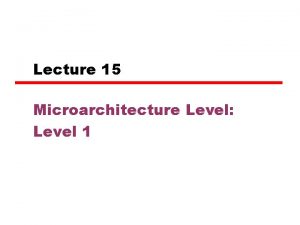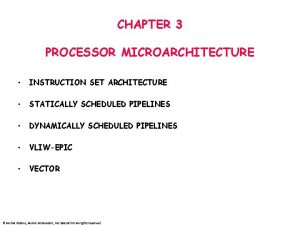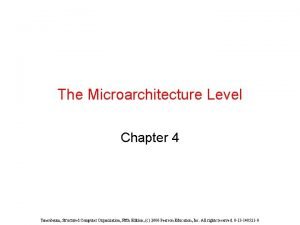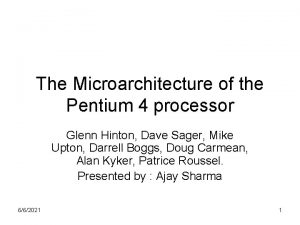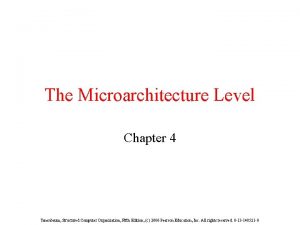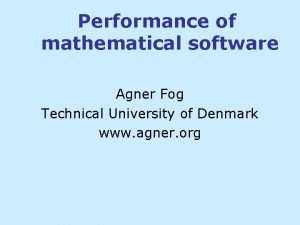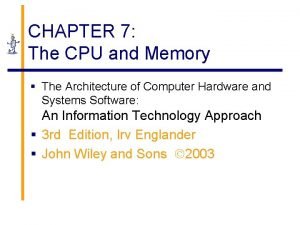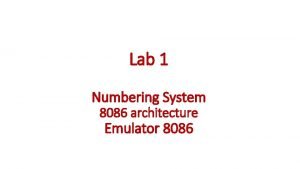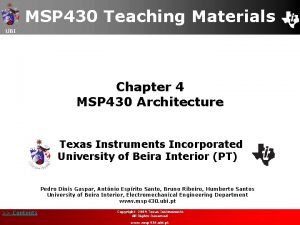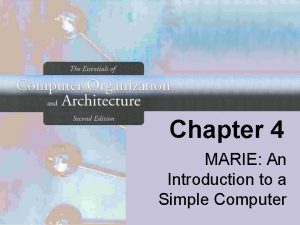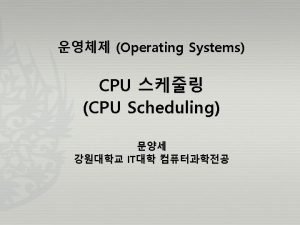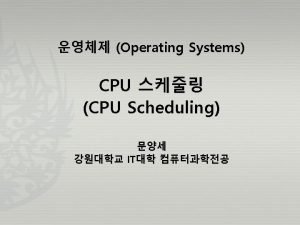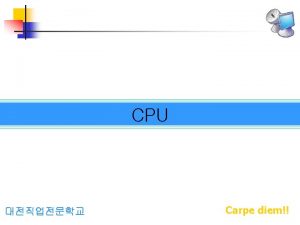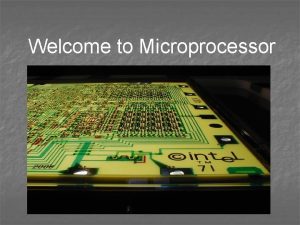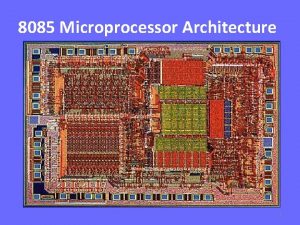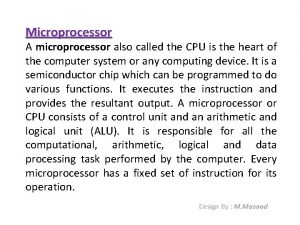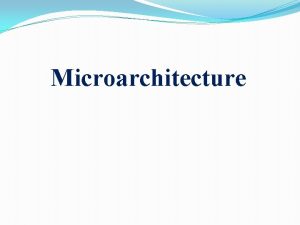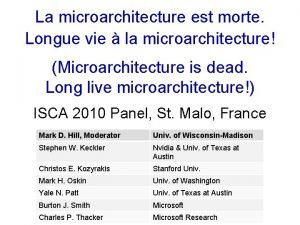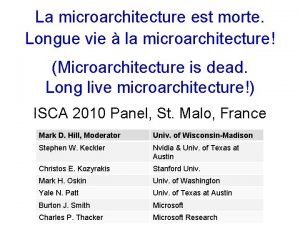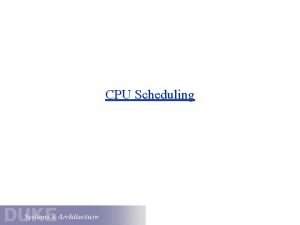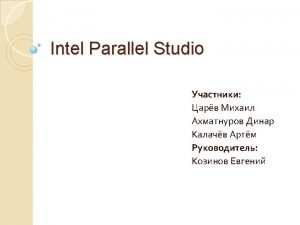Microprocessor Microarchitecture CPU Architecture The Past and Present














- Slides: 14

Microprocessor Microarchitecture CPU Architecture: The Past and Present Lynn Choi School of Electrical Engineering

Contents Performance of Microprocessors q Past: ILP Saturation q I. Superscalar Hardware Complexity II. Limits of ILP III. Power Inefficiency q Present: TLP Era I. Multithreading II. Multicore q Present: Today’s Microprocessor Intel Core 2 Quad, Sun Niagara II, and ARM Cortex A-9 MPCore q Future: Looking into the Future I. Manycores II. Multiple Systems on Chip III. Trend – Change of Wisdoms

CPU Performance q Texe (Execution time per program) = NI * CPIexecution * Tcycle NI = # of instructions / program (program size) CPI = clock cycles / instruction Tcycle = second / clock cycle (clock cycle time) q To increase performance Decrease NI (or program size) - Instruction set architecture (CISC vs. RISC), compilers Decrease CPI (or increase IPC) - Instruction-level parallelism (Superscalar, VLIW) Decrease Tcycle (or increase clock speed) - Pipelining, process technology

Advances in Intel Microprocessors SPECInt 95 Performance 80 81. 3 (projected) Pentium IV 2. 8 GHz (superscalar, out-of-order) 70 60 42 X Clock Speed ↑ 2 X IPC ↑ 50 45. 2 (projected) Pentium IV 1. 7 GHz (superscalar, out-of-order) 40 24 Pentium III 600 MHz (superscalar, out-of-order) 30 3. 33 Pentium 100 MHz 1 (superscalar, in-order) 80486 DX 2 66 MHz (pipelined) 20 8. 09 11. 6 PPro 200 MHz (superscalar, out-of-order) Pentium II 300 MHz (superscalar, out-of-order) 10 1992 1993 1994 1995 1996 1997 1998 1999 2000 2002

Microprocessor Performance Curve

ILP Saturation I – Hardware Complexity Palacharla & Smith, IEEE, All rights reserved q Superscalar hardware is not scalable in terms of issue width! Limited instruction fetch bandwidth Renaming complexity ∝ issue width 2 Wakeup & selection logic ∝ instruction window 2 Bypass logic complexity ∝ # of FUs 2 Also, on-chip wire delays, # register and memory access ports, etc. q Higher IPC implies lowering the Clock Speed!

ILP Saturation II – Limits of ILP Even with a very aggressive superscalar microarchitecture ü 2 K window üMax. 64 instruction issues per cycle ü 8 K entry tournament predictors ü 2 K jump and return predictors ü 256 integer and 256 FP registers Available ILP is only 3 ~ 6!

ILP Saturation III – Power Inefficiency q Increasing issue rate is not energy efficient Hardware complexity & Power Peak issue rate Sustained issue rate & Performance q Increasing clock rate is also not energy efficient Increasing clock rate will increase transistor switching frequency Faster clock needs deeper pipeline, but the pipelining overhead grows faster q Existing processors already reach the power limit 1. 6 GHz Itanium 2 consumes 130 W of power! Temperature problem –Pentium power density passes that of a hot plate (‘ 98) and would pass a nuclear reactor in 2005, and a rocket nozzle in 2010. q Higher IPC and higher clock speed have been pushed to their limit!

TLP Era I - Multithreading q Multithreading Interleave multiple independent threads into the pipeline every cycle - Each thread has its own PC, RF, branch prediction structures but shares instruction pipelines and backend execution units Increase resource utilization & throughput for multiple-issue processors - Improve total system throughput (IPC) at the expense of compromised single program performance Superscalar Fine-Grain Multithreading SMT

TLP Era I - Multithreading q IBM 8 -processor Power 5 with SMT (2 threads per core) Run two copies of an application in SMT mode versus single-thread mode 23% improvement in SPECint. Rate and 16% improvement in SPECfp. Rate

TLP Era II - Multicore q Multicore Single-chip multiprocessing Easy to design and verify functionally Excellent performance/watt - Pdyn = αCL * VDD 2 * F - Dual core at half clock speed can achieve the same performance (throughput) but with only ¼ of the power consumption ! 6 Dual core consumes 2 * C * 0. 52 V * 0. 5 F = 0. 25 CV 2 F Packaging, cooling, reliability - Power also determines the cost of packaging/cooling. - Chip temperature must be limited to avoid reliability issue and leakage power dissipation. Improved throughput with minor degradation in single program performance - For multiprogramming workloads and multi-threaded applications

Today’s Microprocessor q Intel Core 2 Quad Processor (code name “Yorkfield”) Technology - 45 nm process, 820 M transistors, 2 x 107 mm² dies - 2. 83 GHz, two 64 -bit dual-core dies in one MCM package Core microarchitecture - Next generation multi-core microarchitecture introduced in Q 1 2006 6 Derived from P 6 microarchitecture - Optimized for multi-cores and lower power consumption 6 Lower clock speeds for lower power but higher performance 6 1/2 power (up to 65 W) but more performance compared to dualcore Pentium D 6 14 -stage 4 -issue out-of-order (OOO) pipeline - 64 bit Intel architecture (x 86 -64) 2 unified 6 MB L 2 Caches 1333 MHz system bus

Today’s Microprocessor q Sun Ultra. SPARC T 2 processor (“Niagara II”) Multithreaded multicore technology - Eight 1. 4 GHz cores, 8 threads per core → total 64 threads - 65 nm process, 1831 pin BGA, 503 M transistors, 84 W power consumption Core microarchitecture - Two issue 8 -stage instruction pipelines & pipelined FPU per core 4 MB L 2 – 8 banks, 64 FB DIMMs, 60+ GB/s memory bandwidth Security coprocessor per core and dual 10 GB Ethernet, PCI Express Oracle. All rights reserved

Today’s Microprocessor q Cortex A-9 MPCore ARMv 7 ISA Support complex OS and multiuser applications 2 -issue superscalar 8 stage OOO pipeline FPU supports both SP and DP operations NEON SIMD media processing engine MPCore technology that can support 1 ~ 4 cores ARM Ltd. All rights reserved
 Microinstruction
Microinstruction Isa definition computer
Isa definition computer Processor microarchitecture
Processor microarchitecture Microarchitecture diagram
Microarchitecture diagram µops
µops Tanenbaum computer architecture
Tanenbaum computer architecture Agner fog instruction tables
Agner fog instruction tables Past perfect continuous past continuous
Past perfect continuous past continuous Simple past vs past perfect
Simple past vs past perfect Past tense past continuous past perfect
Past tense past continuous past perfect Types of cpu architecture
Types of cpu architecture 8086 emulator
8086 emulator Fundamentals of cpu in advanced computer architecture
Fundamentals of cpu in advanced computer architecture Msp430 risc cpu architecture
Msp430 risc cpu architecture Marie's cpu architecture
Marie's cpu architecture
